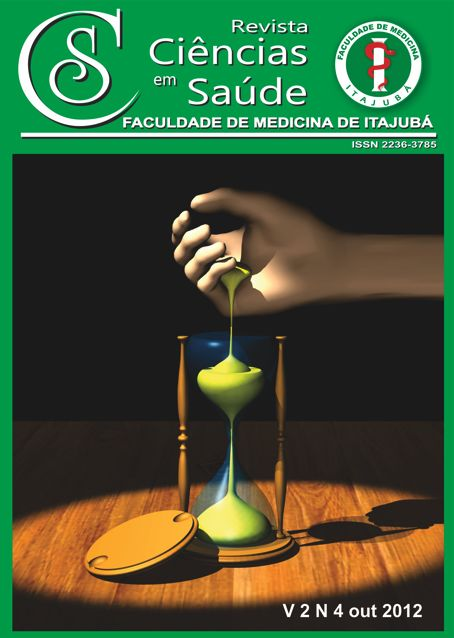Insatisfação Corporal e Atitudes Alimentares de Adolescentes de uma Escola Particular em um Município do Sul de Minas Gerais/Body Dissatisfaction and Eating Habits of Adolescents in a Private School in a Municipality in Southern Minas Gerais
Main Article Content
Abstract
Objetivo: Objetivou-se identificar a prevalência de atitudes alimentares inadequadas e de insatisfação com a imagem corporal de adolescentes do sexo feminino de uma escola particular, bem como analisar a possível associação entre as duas prevalências. Materiais e métodos: Aplicaram-se os questionários Eating Attitudes Test - EAT- 26 e Body Shape Questionnaire – BSQ em 59 adolescentes de 10 a 17 anos, matriculadas em um colégio particular de Maria da Fé - MG. Fez-se análise descritiva e estatística pelo teste Qui-quadrado para associação entre a presença de distorção da imagem corporal e o comportamento alimentar de risco. Resultados: 44,07% das meninas tiveram escore positivo para o EAT-26 e 71,19% apresentaram distorção da imagem corporal, sendo 35,59% com distorção leve, 20, 34% moderada e 15,25% com distorção grave. Os resultados mostraram relação estatisticamente significativa entre a distorção da imagem corporal e o risco de distúrbio alimentar, independente do nível desta distorção. Conclusão: Altos índices de atitudes alimentares inadequadas e de insatisfação com a imagem corporal foram encontrados, mostrando a necessidade de implantação de programas de educação nutricional neste colégio.
Palavras chave: adolescentes, imagem corporal, transtorno alimentar
ABSTRACT
Objective: The objective was to identify the prevalence of inadequate dietary attitudes and dissatisfaction with body image of female adolescents in a private school, and examine the possible association between the two prevalences. Materials and methods: the questionnaires Eating Attitudes Test - EAT-26 and Body Shape Questionnaire - BSQ were applied to 59 adolescents aged 10 to 17, enrolled in a private school in Maria da Fé - MG. There was descriptive and statistical analysis by chi-square test for association between the presence of distortion of body image andrisky eating habits. Results: 44,07% of girls had good scores for the EAT-26 and 71,19% showed distortion of body image, and 35,59% showed mild distortion, 20,34% moderate and 15,25% severe distortion. The results showed statistically significant relationship between the distortion of body image and the risk of eating disorders, independent on the level of distortion. Conclusion: High rates of inappropriate eating habits and dissatisfaction with body image were found, showing the need for implementation of nutritional education programs in this school.
Key words: adolescents, body image, eating disorder
Article Details
Authors maintain copyright and grant the HSJ the right to first publication. From 2024, the publications wiil be licensed under Attribution 4.0 International 
 , allowing their sharing, recognizing the authorship and initial publication in this journal.
, allowing their sharing, recognizing the authorship and initial publication in this journal.
Authors are authorized to assume additional contracts separately for the non-exclusive distribution of the version of the work published in this journal (e.g., publishing in an institutional repository or as a book chapter), with acknowledgment of authorship and initial publication in this journal.
Authors are encouraged to publish and distribute their work online (e.g., in institutional repositories or on their personal page) at any point after the editorial process.
Also, the AUTHOR is informed and consents that the HSJ can incorporate his article into existing or future scientific databases and indexers, under the conditions defined by the latter at all times, which will involve, at least, the possibility that the holders of these databases can perform the following actions on the article.
